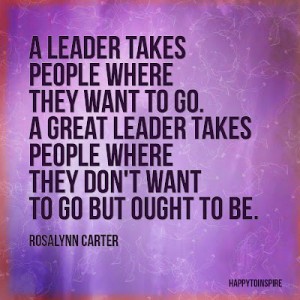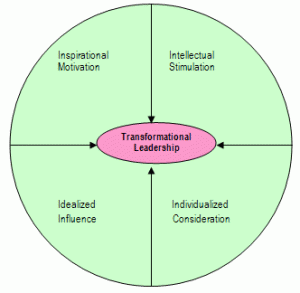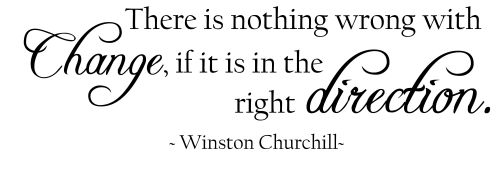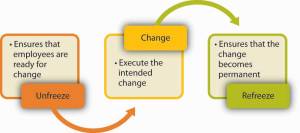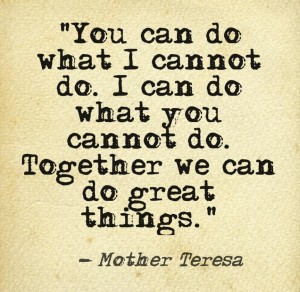The above quote captures the very essence of what my vision of great leadership is. I first saw this inspirational quote in my former manager’s office and it caught my attention right away. It shows what a great leader is capable of doing. Great leaders realize the best qualities and strengths in their employees and try to push them to perform at their highest potential. Their employees may not always be aware of the capabilities they possess at first, but, true leaders have the knowledge and ability to bring out the very best in their employees.
My father possesses the leadership skills that I eventually want to develop. He has worked in the pharmaceutical industry for 34 years and held numerous leadership positions. Through his actions as a father and a friend, he has shown me the qualities I want to foster one day as a leader, myself. He is a very inspirational person, pushes me to be the very best in whatever I do, and is the most supportive and motivational person I have ever known. After graduating from college, I struggled with the idea of what I wanted to do with the rest of my life. For the next few years, I held a variety of internships and jobs, none of which lasted longer than 2 years. During this time, I felt like my career wasn’t progressing like I wanted it to, but he was always there to support me as I changed directions. All my life, my father has been encouraging and motivating me to believe in myself. He has offered advice and guidance while still allowing me to make my own decisions and to enjoy the successes as well as suffer the consequences. I hope to one day inspire and lead individuals in the same way.
As of yet, I don’t know what type of leader I am, however, I would like to develop a charismatic and transformational leadership style. The two styles are very similar to one another. Transformational leaders, a concept first introduced by James MacGregor Burns in 1978, “stimulate and inspire followers to both achieve extraordinary outcomes and, in the process, develop their own leadership capacity” (Bass and Riggio 2008). There are four very important characteristics of transformational leadership, they are: inspirational motivation, intellectual stimulation, idealised influence, and individual consideration.
Charismatic leadership theory, developed by Weber in 1947, articulates “an innovative strategic vision, showing sensitivity to member needs, displaying unconventional behaviour, taking personal risks, and showing sensitivity to the environment,” (Yukul 1999: 293).
Not only do I think these leadership styles are important to adopt, but I would also want to be led by someone with these characteristics. Unlike laissez-faire and authoritarian styles, transformational and charismatic leadership offers a more personal approach. They focus more on employees’ needs while motivating and inspiring. Rather than just focusing on the bottom line, these styles aim to optimise individual performance, which in my opinion is a better way to increase efficiency and effectiveness in most employees.
During week one of my Leading in a Changing World module as part of my global MBA studies at Coventry University London Campus, I was placed into a small group of six students and we were asked to participate in weekly group activities. At the end of each activity, team members were asked to give feedback to one another in the hopes of improving certain leadership skills. By the end of this module, I received incredible feedback which will, without a doubt, help me improve several of my key leadership skills. The following table illustrates some of my strengths and weaknesses that were mentioned:
|
STRENGTHS |
WEAKNESSES |
| Very supportive and quick to give praise for a job well done | Needs to improve in the feedback exercises; doesn’t like to list people’s weaknesses |
| Looks at approaches from different perspectives | Better time management skills |
| Treats other team members with respect | Lack of confidence |
| Great communication skills | Inclined to over worry about situations |
| Extremely organised and goal oriented | Indecisive |
| Great attention to detail | Reluctant to delegate tasks |
| A hardworking individual | Can be a nit-picker |
In week two, my group was asked to build a Lego tower while blindfolded, using specific instructions such as, the tower had to be built with alternating colours. I found it difficult for me to convey to my blindfolded teammate which Lego piece to pick up and where it was on the table, however my teammates noticed during this exercise that I was very supportive and encouraging during the process, and once the right Lego was chosen, I praised them enthusiastically. One area in which I need to improve is providing critical feedback. After each activity, everyone was asked to provided positive and negative feedback to fellow teammates. I know it’s necessary for leaders to be able to do this, but I found it difficult to provide critical feedback face to face with my teammates. However, by the end of the module, it was easier for me. I believe with additional experience I will be better able to provide direct critical feedback and to improve my other weaknesses listed in the table above.
Throughout this module, I have not only learned about, but have been able to practice effective leadership styles. Managers and leaders need to be aware of specific aspects of the workplace, including diversity, change management and business ethics, and they need to have the knowledge and tools to be able to address them in a productive way. This module has helped me to do this and has improved my leadership skills in general.
References
Yukl, G. (1999). An Evalutaion of Conceptual Weakness in Transformational and Charismatic Leadership Theories. The Leadership Quarterly, 10 (2), 285-305
Bass, B. and Riggio, R. (2008). Transformational Leadership. Mahwah, New Jersey: Lawrence Erlbaum Associates, Inc.

